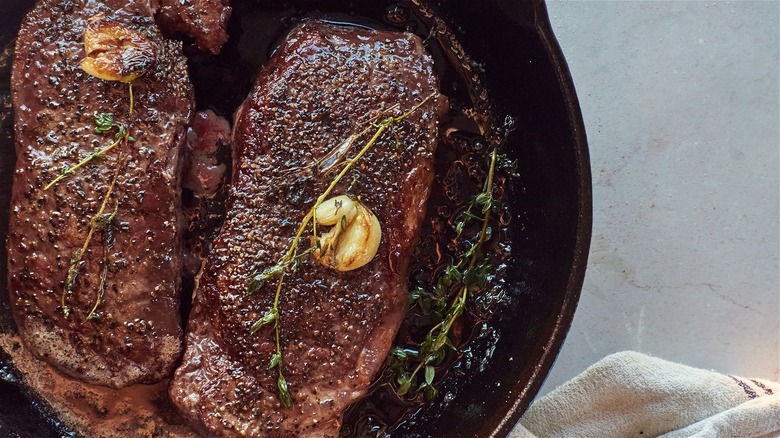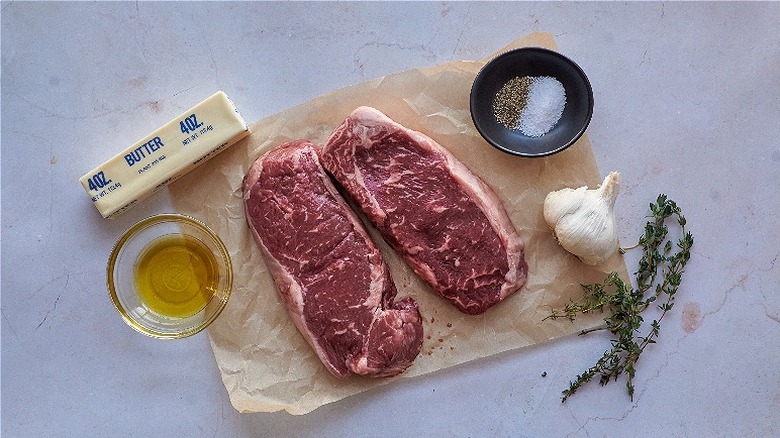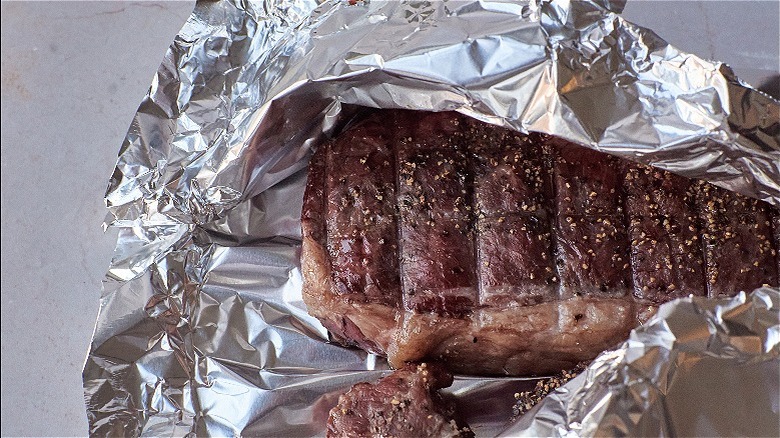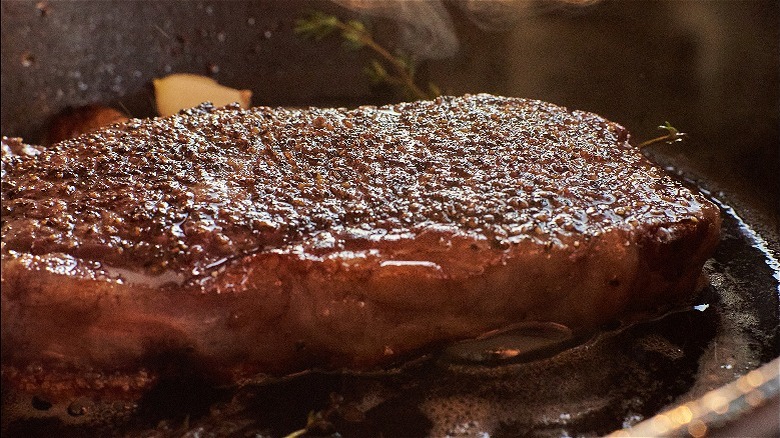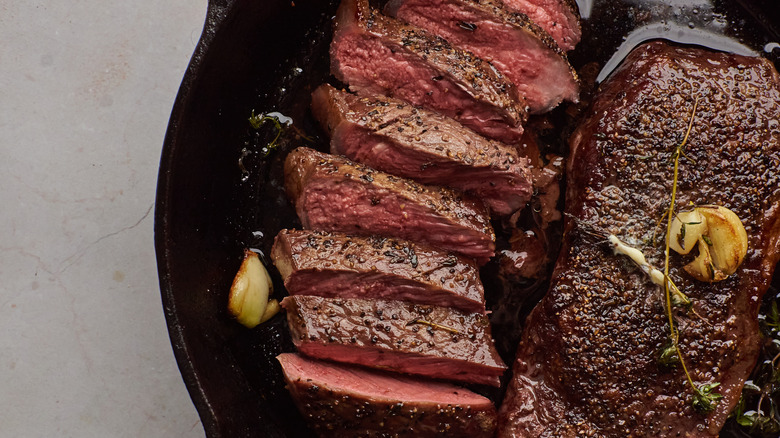Oven To Cast Iron Reverse Sear Steak Recipe
Every steak enthusiast needs the reverse sear in their arsenal, and luckily, it's not hard to master. In fact, the reverse sear is practically foolproof for making perfect, wall-to-wall pink steaks, and a whole lot easier than using a sous vide (and a lot cheaper, too). The key is cooking the steak low and slow first, until it's barely done, then searing the outside until it's crisp. This breaks down and softens the inside of the steak to buttery soft doneness while achieving a perfect crust on the exterior.
And while it takes a little longer than throwing steaks on the grill, it's hardly a slow process compared to cooking pork butt or brisket. Just around 30 minutes in a mildly heated oven will bring your steaks to a juicy medium temperature. In this recipe by developer Michelle McGlinn, the steaks are cooked at 275 F, then seared in a buttered cast iron for a simple, classically-seasoned steak. Salt, pepper, garlic, and fresh thyme are all it takes to make a good steak — that, and great technique.
Grab your reverse-seared steak ingredients
This steak is the embodiment of beautiful simplicity. Reverse searing works best on thick, marbled steaks like New York strips and ribeyes. At the store, find the strips that are an inch or more thick and have plenty of fat marbled on the surface. Feeling fancy? Grab a filet mignon or Tomahawk, and plan to double the cook time. Filets are expensive but deliciously tender, and they're perfect for the slow cooking method. On the other hand, Tomahawks are enormous pieces of meat that require the time and effort that reverse searing provides.
Season the steaks with salt and pepper. That's it — no seasoning blends or coffee rubs, though it would be delicious with those, too. Once the steaks have come to temperature, you'll just need good-quality olive oil, a couple cloves of smashed garlic, plenty of butter, and fresh thyme.
Prep the steaks
A lot of what makes expensive steaks taste so good at restaurants is the prep — and the technique. You could dry-age the steaks in the refrigerator for a day to make them especially tender, or you could simply salt the steaks an hour in advance to dry them out before using. Dry steaks? You heard that right: you want your steak to be completely dry before hitting the pan, so that the surface sears quickly to a crisp. To ensure the steaks stay dry in the oven, set them on a wire rack. Sprinkle salt and pepper generously on each side of the steaks, then press the seasoning into the steaks gently. Let the steaks absorb the salt, while the oven heats up to 275 F.
Cook the steaks in the oven
Cook the steaks in the preheated oven for about 30 minutes, or until it reaches your desired temperature. Especially if you like your steaks on the rare side, the meat will still be mostly pink. Take a meat thermometer, and measure the internal temperature. If it's between 120 and 125 F at this point, you'll be looking at a solid medium-rare steak by the time we're done.
For rare steaks, look for a temperature between 115 and 120 F, and for medium-well or more, cook to somewhere between 125 and 135 F. We still have to sear the steaks, which will raise the temperature by at least 5 degrees, hence why we're cooking them just a little under what we'd normally do for now.
Sear the steaks
To reverse sear the steaks, a nonstick or stainless steel pan will work, but a cast iron heats and maintains a steadily high temperature that is ideal for searing. Heat the pan first, until you can feel the heat by holding your hand a few inches above the pan's surface. Add the oil and butter, and continue heating until the butter is melted and sizzling; do not allow the oil to smoke, or the butter to burn.
Drop in the smashed garlic and thyme, then carefully add the steaks. They'll sizzle loudly and immediately, likely emitting quite a bit of smoke as they hit the skillet. This is normal and ideal for a good sear, so open up the windows. Allow the steaks to sizzle for a minute, then flip. On the second side, baste the butter over the steak using a spoon. If it isn't quite dark enough, just flip again to brown completely. Just don't let the steaks sit too long on the heat, or you'll end up with overcooked steaks.
Slice and serve the steaks
You can tent the steaks again after their finishing sear to keep them warm while you finish any sides. But, with this method of reverse searing, there is no need to preserve the juices with a post-cooking rest. When you cook meat low and slow, the juices never rise to the surface, so you can slice and serve the steaks right off of the cast iron if the rest of your plate is ready.
What can you serve with steak?
As if you were running your own, private steakhouse, keep your sides simple to honor the beauty of your delicately prepared steak. The meat pairs perfectly with mushrooms or mashed potatoes, and it also makes a great accompaniment for lobster tails or seared scallops. On the vegetable front, classic creamed spinach is always a winner, or you could add other greens to a creamy sauce — try this cheesy, keto-friendly Brussels sprouts recipe.
If you want to keep the artisanal energy high on the beverage front, consider crafting cocktails with strong whiskeys. In particular, a classic drink like a Manhattan or a Boulevardier would further the steakhouse feel, as would a glass of a hearty red wine.
How to store and reheat steak
Once it's cooked, steak will keep in the refrigerator for up to 5 days in an airtight container. That said, the fridge also dries out the steak, and reheating the meat quickly (especially in the microwave) ruins the perfect texture you spent all that time achieving. For the best results, McGlinn suggests a low and slow reheat: Place the meat in a 275 F oven and wait, patiently, until the internal temperature reaches around 110 F. You could also purposefully cook your steaks to barely medium-rare before storing them, allowing them to finish cooking to the ideal temperature and texture as they reheat.
Given this quick deterioration in tenderness, some of the the best uses for leftover steak are as a mix-in in a new dish — McGlinn likes steak tacos, a vegetable bowl with cilantro-lime rice, or a saucy steak sandwich.
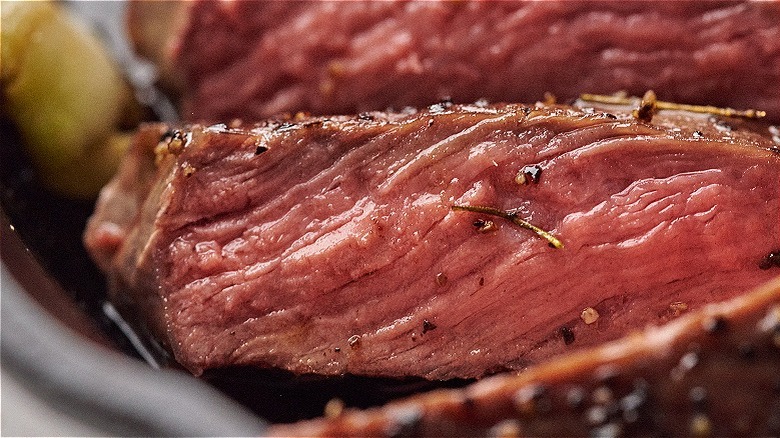
- 2 New York strip steaks, at least 1-inch thick
- 1 tablespoon salt
- 1 tablespoon pepper
- 1 tablespoon neutral oil
- 2 tablespoons butter
- 2 garlic cloves, smashed
- 3 sprigs fresh thyme
- Preheat the oven to 275 F. Pat the steaks completely dry. Season both sides with salt and pepper. Press the seasoning into the steaks, and place onto a baking sheet fitted with a wire rack.
- Place the steaks on the middle rack of the oven, and bake until the internal temperature is 120F or 125F, about 30 minutes. Remove from the oven and tent with foil.
- While the steaks are tenting in foil, heat a cast iron skillet over medium heat until very hot. Add the oil and butter, and allow the butter to melt. Add the garlic and thyme.
- Once the butter has melted, and the oil is sizzling, add the steaks. Sear for 1 minute on each side, just enough to sear a crust onto the exterior. On the second side, baste the butter over the steaks using a spoon.
- Remove from the skillet, and serve steaks immediately.
| Calories per Serving | 895 |
| Total Fat | 70.2 g |
| Saturated Fat | 28.7 g |
| Trans Fat | 0.5 g |
| Cholesterol | 277.4 mg |
| Total Carbohydrates | 4.3 g |
| Dietary Fiber | 1.6 g |
| Total Sugars | 0.1 g |
| Sodium | 774.7 mg |
| Protein | 59.1 g |
